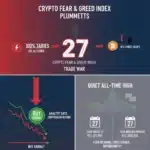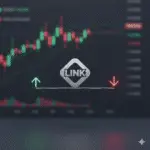Key Highlights
- Bitcoin (BTC) is experiencing sharp price swings, with its volatility surging to the highest levels in the past 30 days.
- A State Street report shows that nearly 60% of institutional investors plan to boost their digital asset exposure in the coming year,
- Regulatory Challenges Emerge Over DeFi
- Innovation continues with Chainlink launching a new RPC endpoint for the HyperEVM testnet to support developers in the HyperliquidX ecosystem.
It’s been a tumultuous period for cryptocurrency traders, with Bitcoin (BTC) prices experiencing significant and rapid fluctuations. After a sharp drop from $123,000 to $120,000 late Thursday, BTC managed to rebound, now trading around $121,400. This volatility isn’t isolated, as privacy coins have also seen notable surges. Even the broader CoinDesk 20 index has shown resilience, recovering from an overnight low of 4,097 points to reach 4,178.
Why the Jitters? The Fed and Volatility
The increased choppiness in Bitcoin’s price movements is largely attributed to the anticipation of another interest rate cut by the U.S. Federal Reserve later this month.
Experts like Nick Forster, founder of decentralized exchange Derive, highlight that “Bitcoin volatility is poised for a breakout.” He notes that implied volatilities across various timeframes (14, 30, and 90-day expiries) have hit their highest levels in the past month, signaling that market participants are bracing for substantial price shifts.
This “vol spike,” as Forster calls it, directly correlates with market expectations of a near-certain 25 basis point rate cut by the Federal Reserve. Betting markets, such as Polymarket, show a strong consensus, with a 91% probability priced in for the Fed to reduce rates by 25 basis points at their October 28-29 meeting. This is happening despite a government shutdown that has delayed the release of crucial economic data. For context, the central bank had already cut rates from 25 basis points to 4% just last month.
Institutional Embrace: A Glimpse into the Future
Beyond the daily price swings, the long-term outlook for digital assets appears increasingly optimistic, especially from the institutional side. State Street’s 2025 digital assets outlook reveals a significant trend: nearly 60% of institutional investors are planning to increase their exposure to digital assets in the coming year. Even more striking, the average institutional exposure to digital assets is expected to double within the next three years. This indicates a growing acceptance and integration of cryptocurrencies and blockchain technology into traditional investment portfolios, moving beyond speculative interest to a more strategic allocation.
Regulatory Hurdles and Innovation Sparks
However, the path to mainstream adoption isn’t without its challenges, particularly on the regulatory front. In the U.S., a group of Democratic senators has reportedly put forth a counter-proposal to the existing market structure bill. This new proposal includes a “restricted list” specifically for DeFi (decentralized finance) protocols that are deemed too risky. Crypto lawyer Jake Chervinsky has voiced concerns that such a move could hinder regulatory progress and potentially undermine the bipartisan support that the Clarity Act received in the House back in July. This highlights the ongoing tension between fostering innovation in the DeFi space and ensuring investor protection and market stability.
Amidst these regulatory debates, innovation continues to flourish. Chainlink, a leading decentralized oracle network, recently launched a Chainlink-grade RPC (Remote Procedure Call) endpoint for the HyperEVM testnet. This development provides builders within the HyperliquidX ecosystem with robust infrastructure. It’s a crucial step for developers working on cutting-edge solutions like HIP-3, vaults, liquid staking tokens (LSTs), and spot deployment, further expanding the capabilities and applications of decentralized technologies.
Global Tensions and Traditional Markets
Looking beyond the crypto sphere, traditional markets are also experiencing shifts influenced by global geopolitical dynamics. The dollar index, a measure of the U.S. dollar’s value against a basket of other major currencies, continues to hover at two-month highs. This strength is partly fueled by China’s decision to tighten its grip on rare earth exports, a move that is ratcheting up economic tensions ahead of an anticipated meeting between President Xi and President Trump in South Korea later this month. These broader macroeconomic and geopolitical trends inevitably ripple through all financial markets, including the volatile world of cryptocurrencies. Staying informed about both crypto-specific developments and the wider economic landscape remains crucial for market participants.










